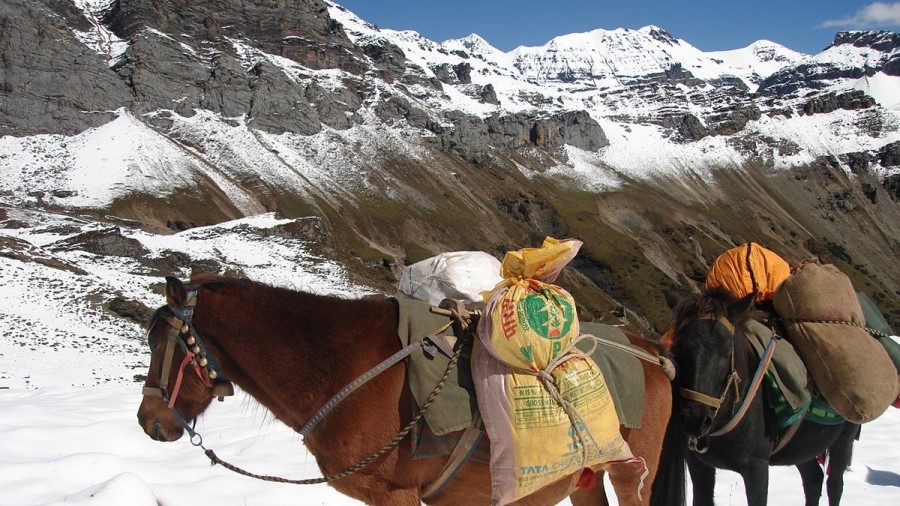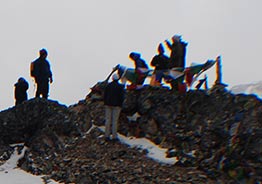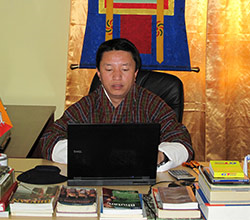Snowman Trek is the most difficult trek in Bhutan! The trek goes via Lingshi, Laya and to the remote Lunana district in northern Bhutan. The trekkers have to walk and camp at the high altitude for nearly three weeks, crossing many passes in course of trek.
The Snowman Trek is considered one of the most challenging and iconic trekking routes in the world, known for its extreme high-altitude and remote wilderness. This trek takes you through the breathtaking landscapes of Bhutan, crossing multiple high mountain passes, and offering a unique adventure for experienced and adventurous trekkers.
The Snowman Trek is a once-in-a-lifetime adventure for trekkers who seek a profound connection with nature, a significant physical and mental challenge, and a chance to experience the remote and untouched beauty of Bhutan’s Himalayas.
Note: This so called ‘Snowman Trek’ is often closed because of snow covered on the passes and is impossible during the winter. The best season would be 1st week of September till Mid October.
Trekking provides the best opportunity to experience and explore the real heart of Bhutan.
Discover a unique insight into the rural culture of the Kingdom of Bhutan.
Close contact with the people living in the remote areas of Bhutan.
Explore and appreciate the pristine environment of Bhutan.
Enjoy with the wilderness experiences in Bhutan.
Explore the adventure tours of Bhutan.
Enjoy with majestic views of the country’s virgin landscapes and unclimbed mountains.
Explore the routes taken by our ancestral.
Trekking through the beautiful lakes of Bhutan.
Day 01. Arrive to Paro International Airport.
The flight into Paro on our national carrier, Druk Air, is a befitting introduction to the spectacular beauty of our country.
In clear weather, magnificent views of the world’s highest peaks like Gangkar Puensum, give way to the lush green Paro valley as you land. Your Bhutanese escort from Authentic Bhutan Tours- Your Trip Organizer in Bhutan! will warmly welcome & greet you on arrival, and then drive you to the Paro Rimpung Dzong, the center of civil and religious authority in this region.
Lunch will be served at Paro Restaurant. After lunch we will visit to Paro National Museum, it holds fascinating collections of art, relics, religious Thangka paintings and Bhutan’s exquisite postage stamps. Evening stroll around Paro town. Welcome dinner and over night stay at Paro hotel. Mandala Resort or similar standard.
Meal Plan: Welcome Dinner Accommodation: Hotel
Day 02. Sharna Zampa – Thangthangkha (Trek Starts)
At around 630am to 7am, we will start our journey to Sharna Zampa, where our trekking staff will be waiting for us.
At Gunitsawa Army post, our Army permit will be checked and endorsed. We will have breakfast and Sharna Zampa, where our trekking cook will prepare for us. After breakfast, we will start our trek. Today’s trek will be a long day trek with lots of small ups and downs.
After going uphill through the river valley the valley finally narrows gradually to a mere path, which descends to a meadow where a camp will be set up. From here, if weather permits, we will have the first great view of Mt. Jomolhari.
Accommodation: Camping Altitude: 3610m. Distance: 22km. Ascent: 770m. Descent: 10m. Time: 7-8hrs.
Day 03. Thangthangkha – Jangothang
Today’s trek continues up the Paro Chhu which widens into patches of alpine meadow and scanty growths of forest. We will cross an army checkpoint along the way and enjoy a spectacular view of high mountain ridges and snow-capped peaks. In this area yaks and their herder’s homes become a regular feature of the landscape. Passing the villages Soe, Takethang and Dangochang is another asset on this day. After reaching Jangothang, one of the most beautiful campsites of the Himalayas, we will have a spectacular view of Mount Jomolhari.
Accommodation: Camping Altitude: 4080m. Distance: 19km. Ascent: 480m. Descent: – Time: 5-6 hrs.
Day 04. Jangothang Halt
Today will have a rest day and it provides plenty of possibilities for day hikes with great views of lakes and snow capped mountains such as Jomolhari and Jichu Drake. There are good chances to spot some blue sheep on the upper slopes of the valley. Jangothang is a perfect environment for your acclimatization. We will trek up to Tshophu Lake.
Day 05: Jangothang – Lingshi
A good day’s walk today with great views of the Jhomolhari, Jichu Drake and the Tserim Gang. We have to cross the Nyelela pass (4,700-m). We pass by the picturesque of Lingshi village and our first views of the truly mystical Lingshi Dzong atop a high hill. Overnight camp at Lingshi
Accommodation: Camping Camp Site: Lingshi Altitude: 4150m Distance: 19 km Ascent: – Descent: – Time: 6 – 7 hours.
Day 06. Lingshi – Chibesa
Today is the shortest walking day, and we can really take it easy. Shortly after starting we will reach a chorten below Lingshi Dzong. Here, we have the choice of staying on the main trail or taking a detour up to the Lingshi Dzong (4,220m), which sits right atop a high ridge. This Dzong is under reconstruction from a 2011 earthquake, which damaged its central building. In addition to a very special atmosphere of mystic tranquility, Lingshi Dzong provides a great view over the valley.
After Lingshi Dzong, we will be passing the villages of Lingshi and Goyul. In Goyul, the stone houses are clustered together to form a small compact village that is unusual in Bhutan where settlements are usually scattered. On reaching the campsite at Chebisa, we will have plenty of time to visit the village houses if you feel up to it. There is also a beautiful waterfall located behind the village that is worth visiting.
Accommodation: Camping Altitude: 3880m. Distance: 10km. Ascent: 280m. Descent: 410m. Time: 5-6 hours.
Day 07. Chebisa – Shomuthang
The morning starts with a long ascent behind Chebisa Village (2-3 hours) through a wide pastureland towards Gobu La (pass). On the way, we will see a few people herding yaks. There is also a great chance to spot large herds of blue sheep above the trail. After crossing Gobu La (4,410m), we descend into the valley, then climb again a little bit, before descending again to Shakshepasa (3,980), a large U-shaped valley. Climbing from here we will finally reach the campsite at Shomuthang, above a river, which is a tributary of the Nochu river
Accommodation: Camping Altitude: 4220m. Distance: 17 km. Ascent: 890m. Descent: 540m. Time: 6-7hrs.
Day 08. Shomuthang – Robluthang
Today’s trek will begin by climbing up the valley to view Kang Bum (6,526 m) and some edelweiss. After two hours of climbing we will reach Jhari La (4,750m), from where we catch the first glimpse of Sinche La, the pass we will have to cross the day after. The big snow peak in the north is Gangchhenta 6,840 m, better known as the Great Tiger Mountain. If weather is clear, Tserim Kang and the top of Jomolhari will be visible. The camp by the river is called Tsheri Jathang located in a beautiful wide and remote valley. Herds of takin, the Bhutanese National Animal, migrate to this valley in summer and remain for about four months. The valley has been declared as Takin sanctuary. Climb up a little bit and we will reach the campsite at Robluthang in a rocky meadow.
Accommodation: Camping Camp Site: Robluthang Altitude: 4160m. Distance: 18 km. Ascent: 700m. Descent: 760m. Time: 6-7hrs.
Day 09. Robluthang – Limithang
The trek starts out with an initial 40-60mins ascent before gradually raising for another 1.5 hours through a boulder field. It is then a 1hour steep ascent before reaching Sinche La (5,005m) – the final and highest pass on the trek if we don’t intend to continue the Snowman trek from Laya onwards.
As we descend the far side of the pass, we will see an impressive terminal moraine and a glacial lake at the foot of the valley. We can see classic examples of lateral moraines where the glacier has pushed rocks up both sides of the valley. Below the moraine, we will cross the Kango Chhu and soon reach the Limithang campsite. The peak of Gangchhenta towers over the campsite even though it’s quite a distance away
Accommodation: Camping Camp Site: Limithang Altitude: 4140m. Distance: 19km. Ascent: 850m. Descent: 870m. Time: 6-7hrs.
Day 10. Limithang – Laya
Today, we will walk downhill all the way along a narrow, winding river valley. After a long time, the trail takes us through densely forested region. The trail leads to the west side of Laya village. From the west of the village we will have spectacular views of Mt. Gangchhenta and catch Mt. Masagang. In the village center is a community school and a basic health unit with a telephone connection. The campsite is located below the school.
Accommodation: Camping Camp Site: Laya village Altitude: 3840m. Distance: 10 km. Ascent: 60m. Descent: 340m. Time: 4-5hrs.
Day 11. Laya Stay
Explore the Laya village.
Day 12. Laya – Rhoduphu
From Laya we descend to an army camp and continue following the river till the turn off point to Rhoduphu. After lunch the climb continues through rhododendron bushes till you reach the camp at Roduphu just next to the Rhodu.
Accommodation: Camping Altitude: 4160m. Distance: 19km. Ascent: 1030m. Descent: 750m. Time: 6-8hrs.
Day 13. Rhodophu – Narethang
After following the river for about half an hour you will have a steady climb to a high open valley at 4,600m and then further up to Tsomo La (4,900m). Tsomo La offers a superb view of Lunana, Mount Jomolhari and Jichu Drake, and the Tibetan border. The route then crosses a flat, barren plateau at about 5,000m. The campsite at Narethang is towered by the peak of Gangla Karchung (6,395m).
Accommodation: Camping Altitude: 4900m. Distance: 17km. Ascent: 740m. Descent: – Time: 5-6hrs.
Day 14. Narethang – Tarina.
From the camp you will climb for about an hour to Gangla Karchung La (5,120m). The view from the pass is breathtaking and the whole range of mountains including Jekangphu Gang (7,100m), Tsenda Kang and Teri Gang (7,300m) can be seen. The pass descends along a large moraine.
Again one has great views: a massive glacier descends from Teri Kang to a deep turquoise lake at its foot. Up here a glacial lake burst through its dam in the early 1960s, causing widespread damage and partially destroying Punakha Dzong. Finally, it is a very long descent through thick rhododendron to Tarina valley, where you will find several good campsites along the Tang Chhu.
Accommodation: Camping Altitude: 3970m. Distance: 18km. Ascent: 270m. Descent: 1200m. Time: 5-6hrs.
Day 15. Tarina – Woche
The walk leads down through conifer forests following the upper ridges of the Pho Chhu, passing some impressive waterfalls. The trail then climbs over a ridge and drops to Woche, a settlement of a few houses, the first village in the Lunana region.
Accommodation: Camping Altitude: 3910m. Distance: 17km. Ascent: 270m. Descent: 330m. Time: 6-7 hrs.
Day 16. Woche – Lhedi
The trek starts through juniper and fir forests, and further ahead, through rhododendron bushes. Climb up to Keche La pass (4,650m) where one can have the great view of surrounding mountains again. After the pass, descend to the riverside walking through a village with a stunning view of Table Mountain and others. Follow up the river till Lhedi Village. Lhedi has a basic health unit, a school and a wireless telephone connection.
Accommodation: Camping Altitude: 3700m. Distance: 17km. Ascent: 980m. Descent: 1190m. Time: 6-7 hrs.
Day 17. Lhedi – Thanza
In clear weather, you will have great views of Table Mountain (7,100m). Around lunchtime you will pass the small village of Chozo (4,090m), which has a dzong still in use. Reaching Thanza again you will have a great view of Table Mountain which forms a 3,000m high wall of snow and ice behind the village. Although there are possibilities to camp directly at Thanza, most groups prefer to camp in Thoencha.
Accommodation: Camping Altitude: 4150m. Distance: 17km. Ascent: 450m. Descent: – Time: 7-8hrs.
Day 18. Rest day at Thanza.
Today we will walk around and experience some village life or climp up to the ridge for fascination views of lakes and mountains.
Day 19. Thanza – Danji
From Thoencha, the trail climbs up to a large boulder from where you will have excellent views of Thanza, Toencha and Choso village and the surrounding mountains. After a few hours of relatively flat and easy walking, you will reach a yak meadow with some yak herders’ huts. An excellent campsite with a great chance to spot some blue sheep on the hills above.
Accommodation: Camping Altitude: 4230m. Distance: 8km. Ascent: 80m. Descent: – Time: 3-4hrs.
Day 20. Danji – Tshochena
Having chosen the route to Sephu, the trek crosses the creek and after a long climb, you will reach Jaze La (5,150m) with spectacular panoramic mountain views . The path then descends between snow covered peaks and a couple of small lakes to the campsite near the shore of Tshochena lake.
Accommodation: Camping Altitude: 4970m. Distance: 12km. Ascent: 980m. Descent: 240m. Time: 5-6 hrs.
Day 21: Tshochena – Jichu Dramo
You will follow the bank of the blue green lake before arriving at a ridge at 5,100m, where there is another spectacular view in all directions. After going up and down over small hills to reach a glacial lake, the route descends first before climbing again up the next pass, the Loju La (5,140m). Finally after crossing a small saddle (5,100m) you will enter a wide glacial valley from where the trail descends gradually to the campsite at Jichu Dramo.
Accommodation: Camping Altitude: 5050m. Distance: 14km. Ascent: 230m. Descent: 150m. Time: 4-5hrs.
Day 22. Jichu Dramo – Chukarpo
Right after leaving the camp you will climb through a moraine to Rinchen Zoe La (5,320m). Spectacular mountain scenery with Gangkhar Puensum amongst the impressive mountains is the reward for climbing the highest pass on this trek route. Rinchen Zoe Peak (5,650) towers above the pass the west.
Descending from the pass, the route leads into a wide valley with several lakes and goes steeply down along a moraine to the Thamphe Chhu. Here the vegetation begins to thicken again and you will see the first real trees since Lhedi. After a couple of hours you reach the campsite at Chukarpo.
Accommodation: Camping Altitude: 4600m. Distance: 18km. Ascent: 320m. Descent: 730m. Time: 5-6hrs.
Day 23. Chukarpo – Thampe Tsho
The descent continues along the river till you reach the yak herder huts at Gala Pang Chhu (4010m). From here the trail climbs steeply towards Thampe Tsho, a beautiful clear turquoise lake, with the campsite next to it.
Accommodation: Camping Altitude: 4300m. Distance: 18km. Ascent: 400m. Descent: 700m. Time: 5-6 hrs.
Day 24. Thampe Tsho – Maurothang
From the lake you climb steeply to the last pass on your trek, the Thampe La (4,600m) with a good chance to spot some blue sheep on the way. Then the path descends to the sacred lake Om Thso. Passing a waterfall you will reach another, smaller lake 100m below to descend steeply to the Nikka Chhu. The path finally leads through mixed forest to large clearing on the banks of the river with a few yak herder huts, Maurothang.
Accommodation: Camping Altitude: 3610m. Distance: 14km. Ascent: 330m. Descent: 1020m. Time: 5 hrs.
Day 25. Maurothang – Sephu
On the last day of this extraordinary trek your porters will have to change from yaks to horses as the yaks will not be willing to go further down. The path follows the Nikka Chhu to reach a large grassy area overlooking the road and the village of Sephu.
You finally reach the road at the Nikka Chhu bridge at Sephu where you will find several stores (mainly selling bamboo products) and small restaurants. We will say goodbye to our trekking staff and then drive to Gangtey. Dinner and overnight stay at hotel Gangtey. Gakingling Guest House or similar standard.
Accommodation: Hotel Distance: 18km. Ascent: – Descent: 990m. Time: 5-6hrs.
Day 26. Gangtey – Thimphu.
After the breakfast, we will drive to Thimphu via Punakha. Before we drive, we will visit to Gangtey Goenpa Lhakhang. Then we drive, on reaching Lobesa, we will hike to Chhimi Lhkhang, the temple of fertility. Luch will be served at Chhimi Lhakhang Cafteria.
After lunch we will visit Punakha Dzong, the most beautiful dzong in Bhutan. it was the winter capital of Bhutan until 1955 when the capital was permanently shifted to Thimphu. It still served as the winter resident for the central monastic body. Lunch at Punakha. After lunch continue our journey to Thimphu over docula pass (3150m).
Evening stroll around Thimphu Valley. Dinner and over night stay at hotel Thmphu. Hotel Peaceful Resort or similar standard.
Day 27. Thimphu Stay
Sightseeing in Thimphu, visit to Memorial Chhorten, built in 1974 in the memory of third king late Jigme Dorji Wangchuk, and the temple inside gives good examples of tantric Buddhist and its philosophy. Mothithang minizoo to see the National Animal of Bhutan (Takin), Zulikha Nunnery, the Thangtong Dewachen nunnery was founded in 1976 by Rikey Jadrel and today it houses the sixty nuns engaged in Buddhist study and practices.
Folk Heritage Museum, this Folk Heritage Museum is a showcase, the 19-century farmhouse and the living style of the Bhutanese family.
National Library, the National Library was established in 1967 to preserve many ancient Dzongkha and Tibetan texts. Lunch in Thimphu town.
After lunch, visit Paper Factory, were Bhutanese Traditional Papers & paper products are made. Weaving Center produces hand-woven textiles on site and has a selection of cloth and ready-made garments for sale. This is one of the few places where you can watch weavers at work, and then Authentic Bhutanese handicrafts.
Evening we will visit Bhutanese Farm House for dinner and Traditional Hot Stone bath. Over night stay at Thimphu Hotel or we can organize even in Bhutanese Farm House.
Day 28. Thimphu – Paro
Today we will drive to Paro and hike to Paro Taktshang Monastery, the most famous and sacred monastery in Bhutan. Taktshang means “Tiger’s Nest” named after Guru Rinpoche who reportedly flew to this site riding on the back of a flying tigress in the 8th century. We have to walk about 2hours and 30minutes up-steep from the road end. The trail climbs through beautiful pine forest, many of the trees festooned with Spanish moss, and an occasional grove of fluttering prayer flags. Lunch will be served at Taktshang cafeteria.
While coming back, visit Kyichu Lhakhang, it is one of the two most sacred and the oldest temples in Bhutan, built in 7th century by Tibetan king Songtsen Gampo (the 33rd Tibetan king, who is also the manifestation of Avalokiteshvara, commonly known to Bhutanese as Chenrize).
Evening at leisure, dinner and overnight stay at Paro Hotel. Olathang Hotel or similar standard.
Day 29. Paro – Paro International Airport (Departure)
After our breakfast, we will drive to Paro International Airport for your onward flight. Our guide and driver will bid you farewell here at the airport. We wish you a very safe and pleasant flight for your onward destinations.
Start planning your tailor-made Dream Holiday to Bhutan – The Land of happiness!
In order to experience the best and rewarding fulfillment clients must plan in advance the different logistics that you have in your minds before actually venturing into the world of trips. You might have wishes and hopes for which you need to plan.
The following information will help you to plan your dream trip to Bhutan.
1. When and how to visit Bhutan?
Choose your traveling date like Arrival/Departure date. You also need to choose entry/depart Bhutan via AIR or LAND.
By Air: Druk Air, the national carriers is the only service operator in the kingdom and operates several flights per week from Bangkok (Thailand), Delhi & Kolkata (India) and Kathmandu (Nepal) to Paro (Bhutan). The Paro International Airport is located about an hour and a half drive from Thimphu, the capital city of Bhutan.
Paro airport is daylight restricted, and the flights are totally dependent on the weather. As a result, sometimes flights are delayed. It is therefore a good idea to keep at least 24 hours of transit time for connecting flights out of Paro. You might also want to consider traveling on a non-restricted ticket so that if you miss a connecting flight, you can be rerouted or seated on the first available carrier.
Sometimes flights into Paro are disrupted because of unfavorable weather conditions. If this occurs, the flight will stop for the night at the transit airport. To be prepared, you may want to carry your essential personal items in your carry-on luggage.
By Land: Phuentsholing, a Bhutanese town in the southwest has road access to India. It is located about 170 km from the Indian domestic airport at Bagdogra, West Bengal. Phuentsholing is about 172 km from Thimphu the capital city of Bhutan and is about 6hours drive distance. And S/
2. What are your itineraries?
All the tours can be customized and extended as per our valued client’s requirements. There are sample itineraries for your kind reference and it will give you some general idea of the likely trip scheduled.
Complete the tour request form and submit it to us. Send us correct name list. We will send you the flight reservation status via email.
After confirming your reservation, we need the scanned copy of member’s passport.
Please remit us full payments and send us the copy of remittance paper via email. Visa will not be accepted without full payment.
We will send you the flight ticket copy and Visa Clearance Copy prior to your departure to Bhutan via email. You need to print out and carry along with you.
Start packing and looking forward to have a memorable trip in the LandThunder Dragon, DrukYul.
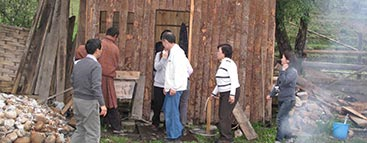
Hot stone bath (Dhotsho) is a traditional bath of Bhutan, where a tradition of heating up stones and then soaking in the water that is in turn heated by the stones. This is also a curative method and is used throughout the country We Bhutanese belief that this bath has so much of medicinal benefits. Some diseases are curable-like joint pains, hypertension, stomach disorder, arthritis and many other minor diseases. Especially for the old age, where we have lots of body pains, joints pains helps a lot by this Hot Stone Bath (Dhotsho).
I think, the minerals in the rocks have certain chemicals, which can cure certain disease of our body. Hot stone bath has no side effects. It is in its pure natural form. We can organize the hot stone bath during your stay in Bhutan.
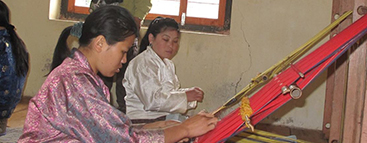
The Bhutanese textiles are rich, vibrant, and colorful and are a complex art form as well as an integral part of the Bhutanese culture. This Bhutan weaving experiences will give you an insight about the rich textiles in Bhutan. You can sit one of the handlooms of Bhutan and weave your self practically. We promise that you will really enjoy this with great satisfaction in your life.
We will also see or learn the natural coloring and dyeing. You can bring your own materials like handkerchief to dye and color. So visit Bhutan and experience it practically by yourself.
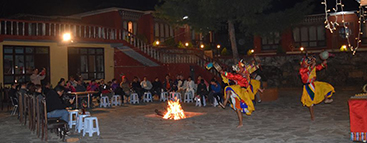
Folk Performing Arts & Music in the Himalayan Kingdom of Bhutan
We have Cultural Program Performing groups, which they will perform like Traditional folk songs, dances and keeps original tunes and dances alive. Moreover, new choreography for some traditional and regional songs is sometimes developed.
The troupe also performs mask dances that have historical and spiritual significance.
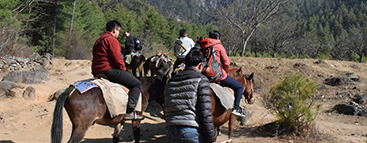
Tiger’s Nest is most visited spot in Bhutan and it is much awaited by every tourist who visits Bhutan to climb to Tiger’s Nest.
It takes about 2 hrs 30mins up steep climb through the forest of pine, oak and Rhododendron. However you can ride the horse and climb till the Taktshang cafeteria.
Our company will provide the Trekking Equipment like Tents (Sleeping, Dinning, Toilet, Shower Tents), Mattress, Hot-Water bag, Cooking Utensils, Sleeping Bags. But we advise our clients to bring their own sleeping bags, if they can. However our guests have to bring some trekking gears by themselves. Therefore, everything mentioned below on the list are useful, and most of the things are important on trek.
Equipment for all the trekkers
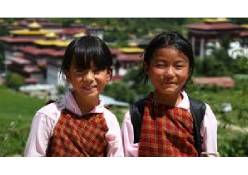
Footwear
camp shoes or thongs
socks – polypropylene
Clothing
jumper or pile jacket
hiking shorts (men) or skirt (opt)
waterproof jacket, poncho or umbrella
hiking pants
T- shirts or blouses
underwear, sun hat
swimwear (opt.)
insulated paints
nylon wind breaker
nylon wind pants
long underwear
woolen hat
gloves
long gaiters
Above 4000 m.
socks, wool, to wear with boots
socks, light cotton, for under wool socks
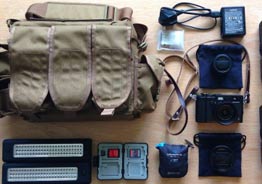
Photography Equipments
( Optional )
lenses cleaning equipments
film
compass
thermometer
binoculars
books for reading while waiting for plane
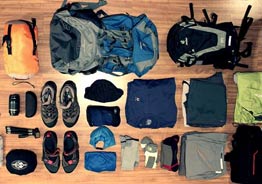
Other Equipments
sleeping bag
water bottle
torch
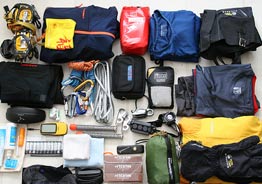
Miscellaneous Items
toilet paper and cigarette lighter
small knife
sun block
towel
laundry soap
medical and frist aid kit
pre-moistened towelettes
sewing kit
sunglasses
sun block for lips


